Neonatal Intensive Care Unit
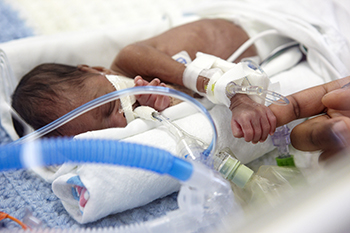
PREMATURITY
A term birth has been defined as between 37 and 42 weeks. Preterm birth is commonly defined as any birth before 37 weeks completed weeks of gestation.
• Late preterm, born between 34 and 36 completed weeks of pregnancy
• Moderately preterm, born between 32 and 34 weeks of pregnancy
• Very preterm, born at less than 32 weeks of pregnancy
• Extremely preterm, born at or before 25 weeks of pregnancy
Understanding an infant’s different ages:
Gestational age– age from conception to birth, calculated in weeks.
Chronological age– age since birth. Birthdays are celebrations of a child’s chronological age.
Corrected age– age your baby would be if they had been born on their due date.
To calculate corrected age, start with the baby’s chronological age in weeks (the number of weeks since birth) and subtract the number of weeks your baby was prematurely (40 weeks – gestational age).
For example:
A baby born at 25 weeks gestation, is now 27 weeks old.
Gestational age: 25 weeks
How many weeks born early: 15 weeks (40 weeks – 25 weeks = 15 weeks)
Chronological age is 27 weeks (27 weeks have passed since his birth).
Corrected age: 27 weeks – 15 weeks = 12 weeks or 3 months corrected.
For preterm babies, you need to correct their age until they are two or three years, as by this time most children would have caught up developmentally to their peers.
NICU Terminology
| Term | Explanation |
| Apnea of prematurity (also called AOP) | A term that means breathing has stopped for more than 20 seconds. It can happen in full-term babies, but it’s more common in premature babies. The more premature the baby, the greater the chances that apnea will occur. |
| A’s and B’s | An abbreviation referring to episodes of apnea and bradycardia; see APNEA and BRADYCARDIA. |
| Bronchopulmonary dysplasia (also called BPD) | A form of chronic lung disease that develops in preterm neonates treated with oxygen and positive-pressure ventilation. |
| Central Catheter or Central Line
|
A thin, flexible tube (catheter) placed in a larger vein or artery to deliver medications or necessary fluids and nutrients to the body.
|
| CPAP- Continuous Positive Airway Pressure | A form of ventilator assistance which helps to keep the baby’s lungs properly expanded. CPAP does not breathe for the baby but allows the baby to breathe into a “wind.” |
| Gavage feedings | Feedings delivered by a small plastic tube placed through the nose or mouth and down into the stomach when the baby is too weak or too premature to suck and swallow. |
| Heel Stick | A quick prick of the heel with a sterile instrument (much like a finger prick) to obtain small blood samples for tests. |
| Intraventricular hemorrhage (also called IVH)
|
Bleeding inside or around the ventricles in the brain. IVH is most common in premature babies. There are 4 grades of IVH, depending on the amount of bleeding. Grade 1. Bleeding occurs just in a small area of the ventricles. Grade 2. Bleeding also occurs inside the ventricles. Grade 3. Ventricles are enlarged by the blood. Grade 4. Bleeding occurs in the brain tissues around the ventricles.Grades 1 and 2 are most common. Often the baby has no other complications. Grades 3 and 4 are the most serious. They may result in long-term brain injury to the baby. |
| Meconium | The first bowel movements that a baby has which are thick, sticky, and dark green to black in color. |
| Meconium Aspiration | The inhalation of meconium into the lungs. If a baby passes meconium before delivery, the meconium may be inhaled into the lungs, causing problems with breathing after the baby is born. This condition is called meconium aspiration syndrome (MAS). |
| Necrotizing enterocolitis (also called NEC) | This is primarily a disease process of the gastrointestinal (GI) tract of premature neonates that results in inflammation and bacterial invasion of the bowel wall. |
| Oxyhood (02 hood) | A clear plastic hood placed over the baby’s head through which oxygen is given. |
| Patent ductus arteriosus (also called PDA) | This s a heart defect found in the days or weeks after birth. The ductus arteriosus is a normal part of fetal blood circulation before a baby is born. It’s an extra blood vessel that connects 2 arteries: the pulmonary artery and the aorta. The pulmonary artery carries blood from the heart to the lungs. The aorta carries blood from the heart to the body. Before birth, the ductus arteriosus lets blood go around (bypass) the lungs. This is because the baby gets oxygen from the mother. |
| Peak Inspiratory Pressure (Pip) | The highest pressure that is delivered to the baby by the ventilator during a forced breath. |
| Peripherally Inserted Central Catheter (PICC Line) | A PICC is a line inserted through a vein and then advanced through increasingly larger veins, toward the heart. Used when IV therapy, antibiotics, or nutrition (TPN/lipids) are administered for a long period of time. |
| PKU | A rare disorder in which one of the amino acids (a building block of protein) cannot be handled normally by the baby, leading to elevated levels in the blood. Babies with PKU require a special diet. All babies are routinely tested for PKU, as well as several other disorders, before going home from the nursery. This test is required by law. |
| Pneumomediastinum | Leakage of air from the normal passageways of the lung into the space surrounding the heart inside the chest. A pneumomediastinum is usually harmless in itself, but is often associated with a pneumothorax (which can be life-threatening if large). |
| Positive End-Expiratory Pressure (Peep) | The lowest pressure that is delivered by the ventilator to the baby between forced breaths. See also PEAK INSPIRATORY PRESSURE (PIP). |
| Respiratory distress syndrome (also called RDS) | This is caused by pulmonary surfactant deficiency in the lungs of neonates, most commonly in those born at < 37 weeks gestation. Risk increases with degree of prematurity. Symptoms and signs include grunting respirations, use of accessory muscles, and nasal flaring appearing soon after birth. |
| Retinopathy of prematurity (also called ROP) | A disease that affects immature vasculature in the eyes of premature babies. It can be mild, or it may become aggressive with new blood vessel formation (neovascularization) and progress to retinal detachment and blindness. The incidence of ROP has increased, as smaller and younger babies are surviving. – Risk factors include: Birth before 32 weeks’ gestation, especially before 30 weeks, and birth weight of less than 1500 g, especially less than 1250 g – Possible risk factors include supplemental oxygen, hypoxemia, hypercarbia, concurrent illness. |
| Umbilical catheter | A small plastic tube in one of the umbilical (belly button) blood vessels (either an artery or a vein). |
| Warmer | Also known as a Radiant Warmer, an open bed allows maximum access to a sick or newly born infant. Radiant heaters above the bed keep the baby warm. |
| TPN or Total Parenteral Nutrition | A type of IV fluid that provides total nutrition to someone who cannot take any nourishment by mouth. TPN is nutrition outside of the digestive system. TPN contains sugars, electrolytes, vitamins, proteins, and can supply all of the nutrients that the body needs. |
OT’S ROLE IN NICU
Occupational therapy intervention includes direct intervention in treating the premature or newborn infant, and the provision of advice and guidance to the parents and to the NICU staff.
| Goal of Intervention | Example | |
| Adapting and modifying the stimuli that the premature or newborn baby is exposed to, and providing the appropriate stimuli and guidance needed to encourage the development of sensory modulation | • Dimming lighting/covering incubator/isolette
• Providing the neonate with boundaries – “cocooning” • Giving infants the opportunity to explore hands to face and mouth • Opportunities for infants to smell mother’s milk • Sucking on a pacifier for self-regulation i.e. Non-nutritive sucking, using correct pacifier size |

|
| Promoting oral feeding | *** If infant and/or mother not coping with breastfeeding, then expressed milk or formula may be given to the baby.
• Skin to skin with mom and opportunities to practice latching at the breast. • Provide external stability for baby by supporting their chin or cheeks (sucking pads), to aid feeding • Assist the pacing of the feed e.g. remove nipple slightly to prompt the infant to breathe |
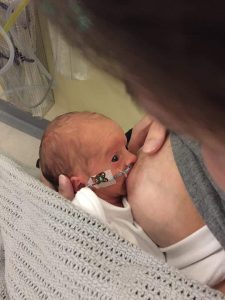
|
| Maintaining adaptive positions that support the infant’s development, including methods of handling and positioning | • Promote a flexed posture and facilitate hands to midline- the infant would normally be in physiological flexion if born at full term. – Swaddling – Side-lying |
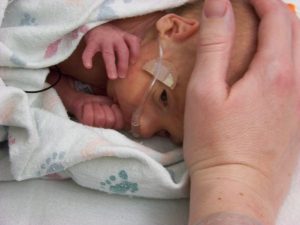
|
| Guiding parents to be actively involved in the day-to-day care of their premature or newborn baby | • Kangaroo care Kangaroo care is a method of holding a baby that involves skin-to-skin contact. The baby, who is naked except for a diaper and a piece of cloth covering his or her back (either a receiving blanket or the parent’s clothing), is placed in an upright position against a parent’s bare chest. |

|
FEEDING
An infant should be at least 32-34 weeks, depending on their clinical status before oral feeds can be introduced.
Preterm infants less than 32 weeks are incapable of independent oral feeding and require gavage feeds. They frequently experience oral feeding difficulties due to underdeveloped oral motor skills and lack of coordination of sucking, swallowing and respiration.
Coordination of swallowing with sucking and breathing reflects the infant’s skill at managing fluid while adequately protecting his airway. Infants learn to swallow efficiently as they mature. Coordinated swallowing includes matching sucking pressure and burst length with efficient swallowing and also completing swallowing before initiating the next breath.
Oral-motor and feeding assessment
Goal
Infant maintains a smooth, rhythmic sucking pattern throughout the feeding, and physiologic stability.
Steps:
1. Observe if infant opens mouth promptly when rooting reflex elicited
2. Evaluate:
i. Palate
ii. Tongue- able to protrude beyond lips (?tongue-tie) and able to cup nipple
iii. Lip closure- good seal around nipple/soother/examiner’s gloved finger
iv. Sucking- strong, sustained and rhythmical
v. Safety to swallow liquid needs to be assessed- Introduce small amount of milk. If no concerns about swallowing, then proceed with oral feed.
3. Determine ability to coordinate sucking with swallowing and breathing (SSB). Ability to coordinate SSB reflects the infant’s skill at managing fluid while adequately protecting his airway.
4. Once feeding is under way, establish ability to maintain a smooth, rhythmic pattern of sucking. A well-coordinated SSB is typically an ability to engage in long sucking bursts (7–10 sucks) without demonstrating behavioral stress signs or an adverse cardiorespiratory response.
5. Ability to maintain physiologic stability is vital and can typically be established in the first 30 seconds into feeding, oxygen saturation is stable, and behavioral stress cues absent.
*** Follow infant’s cues for starting and stopping feedings
Observe for stress signals during feeding. Goal is to maintain physiologic stability rather than respond to distress.
Signs of stress include:
• Using the stop sign by extending upper limb and splaying fingers.
• Arching their back.
• Thrusting their arms and legs rigidly into the air.
• Frowning or scowling.
• Spreading their fingers and toes out.
• Gaze aversion- looking away.


Concerns and confirmation of dysphagia
Videofluoroscopy Swallow Study (VFSS)
• Evaluate safety of the pharyngeal swallow
• Can trial various treatment techniques

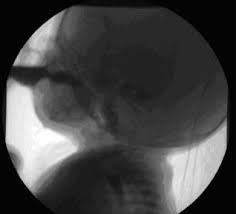
Optimizing feeding conditions, the following adaptations can be made:
• Feeding position – baby in “football hold”, semi-upright position.
• Bottle and nipple type – change shape/flow of nipple.
• Consistency and/or temperature of milk – thicken milk, cold liquids.
• Pacing – Allows sufficient opportunity and time to breathe during feeding by interrupting the flow. For feeding induced apnea, stop flow after 2-3 sucks.

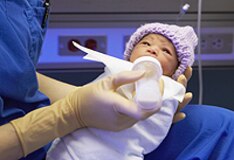
Reflux Management
Reflux is very common among preterm infants and the presence of a NG or OG tube through the gastroesophageal junction can exacerbate it.
Strategies to control reflux
• Positioning- inclined surface so that head is higher than body.
• Thickening milk which creates a more solid bolus and slows transit time.
– Formula: usually use Thick-It or rice cereal.
– Breastmilk: consistent thickening can only be achieved with gum-based thickener (Gel Mix or Simply Thick).
Do not typically consider thickening as an option until infant 42-44 weeks.
• Smaller feeds, more frequently.
References:
https://www.verywellfamily.com/neonatal-lingo-2748438http://
www.goodbeginnings-csmc.org/neonatal/resources/terms.htm